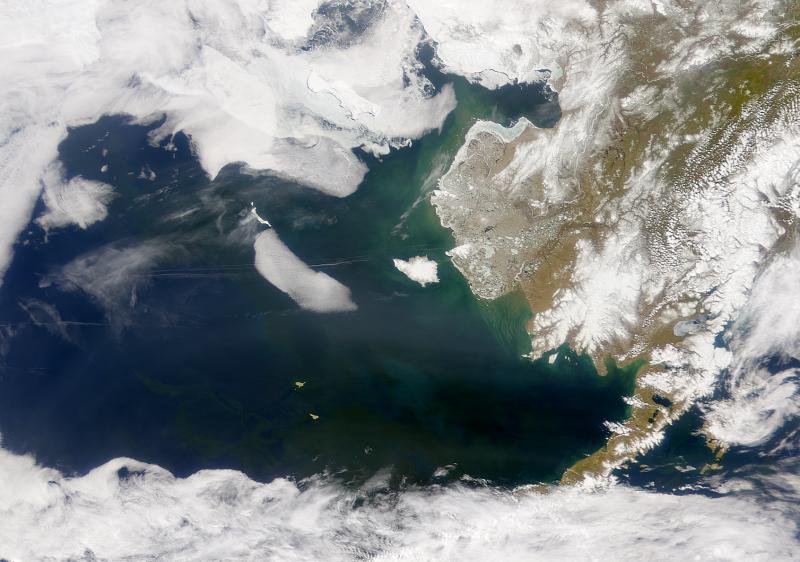New research suggests that warming of the Bering Sea Shelf affects algae blooms and the food web that relies on it. This is particularly true of the recent unprecedented and widespread warming during 2018–2019. Understanding the impacts of the timing of the bloom and its association with sea ice is essential to predicting ecosystem responses to climate change.
The Bering Sea shelf is a highly productive ecosystem that extends 500 kilometers offshore from the Alaska coast. It typically experiences large phytoplankton blooms in spring. In cold, high-ice years in the southern Bering Sea, and all but the warmest years in the northern Bering Sea, the timing of sea-ice retreat is a major driver of spring bloom formation.
At the start of spring, as light levels increase, ice-algae grows on the underside of the ice. As spring progresses and the ice melts, the surface water gets fresher, which creates stratification in the water. This allows the phytoplankton to remain in the well-lit surface layer to grow.
These ice-associated phytoplankton blooms feed zooplankton (e.g. copepods, krill) and other tiny creatures that are important fat-rich foods for young fish, birds and marine mammals. The phytoplankton that do not get eaten fall to the seafloor to support a diverse community of bottom-dwelling invertebrate species, like crab and clams. These species, in turn, are food for walruses and some whales.
“This ecosystem is highly dependent on ice, and when ice retreats, large spring blooms provide food for zooplankton. However, when it is warm, ice melts early, and blooms in open waters (weeks after sea ice has disappeared) become more abundant,” says Jens Nielsen, a biological oceanographer with the Ecosystems and Fisheries-Oceanography Coordinated Investigations Program at NOAA’s Alaska Fisheries Science Center, Pacific Marine Environmental Laboratory and Cooperative Institute for Climate, Ocean and Ecosystem Studies at the University of Washington.
The study shows that the timing of the bloom has not shifted seasonally. However, as climate warming has progressed, open-water blooms have become more widespread.
“If we keep having warm ocean conditions like what occurred from 2018–2019, open-water blooms in both the southern and northern Bering Sea will become the more widespread,” said Jens Nielsen.
Increasing open-water blooms may also redistribute resources away from the seafloor. Ice algae sink faster than open-water phytoplankton. Open-water blooms likely reduce the amount of food resources reaching the seafloor, something NOAA researchers are currently investigating further.
Warming waters in the northern Bering Sea may produce shifts from a benthic toward a more pelagic ecosystem, similar to the southern Bering Sea. Analysis of data over many years will help scientists predict large ecosystem changes.
Mooring and Satellite Data Gives Scientists Big Picture on Large Ecosystem Changes
“We can’t be everywhere at once, so we need tools to monitor what we need,” said Robert Foy, director of NOAA’s Alaska Fisheries Science Center. New tools fill data gaps and increase efficiency in data collection that aids scientists in their research.
In the recent study, scientists estimated spring blooms with a combination of data from moorings on the eastern shelf and satellite ocean color data from 1998 to 2022. Comparing satellite and moorings data is helpful because it can provide more variables that help with the big picture.
Long-term mooring data is maintained by oceanographers at NOAA Pacific Marine Environmental Laboratory. They provide a very detailed seasonal picture of phytoplankton processes in the water column but are restricted to specific locations.
Satellites provide great spatial and temporal coverage but are restricted to measuring the surface of the ocean, and have missing data due to clouds and ice cover. Combining the two methods improve phytoplankton bloom estimates.
“Beyond this paper, we are trying to use satellite data to make models that can predict phytoplankton sizes or specific groups,” said Jens Nielsen. “We do this by linking survey data collected on ships to spectral measurements from airplanes and link this information to what the satellites are seeing. Satellite models can then be developed to calculate phytoplankton size, whether big or small. In the future, we’re hoping this work can also help with monitoring harmful algae blooms which have been increasing in occurrence in recent years.”
Ecosystem Science
For more than 20 years, data from our Ecosystems & Fisheries-Oceanography Coordinated Investigations studies have contributed to annual Ecosystem Status Reports. These reports are used by managers at the North Pacific Fishery Management Council to make resource management decisions that account for ecosystem changes.
“This study fills gaps by including data from the recent warming period 2018–2019 and more spatial information on how blooms vary across the region,” said Jens Nielsen. “Our work lays the foundation for learning more about the link between phytoplankton bloom types and how that influences zooplankton that are food for commercially important fish, and benthic crabs.” Following the recent warm years in 2018–2019, the snow crab population decreased by 80 percent, in part due to starvation. Whether increasing open water blooms increased starvation of commercially important snow crabs needs further investigation.
Monitoring how the ecosystem is changing and providing those data may help Alaska ecosystem managers and communities that rely on commercial, recreational and subsistence harvests plan and adapt.






